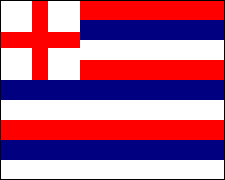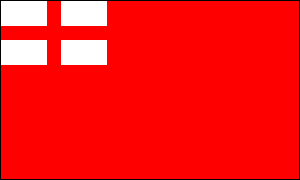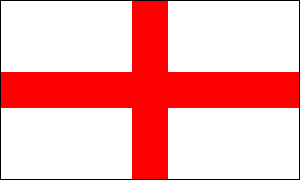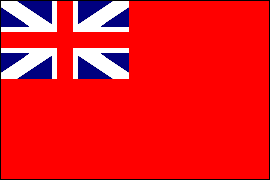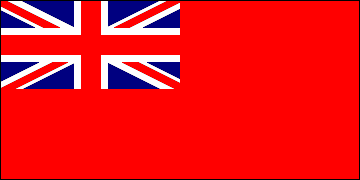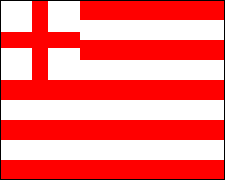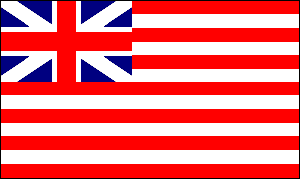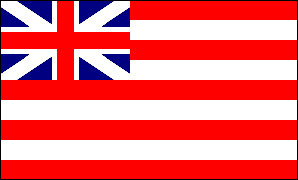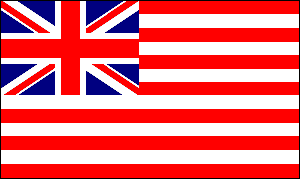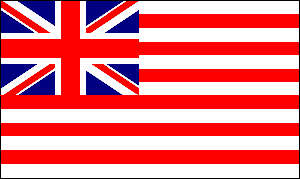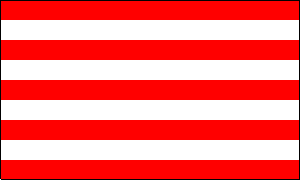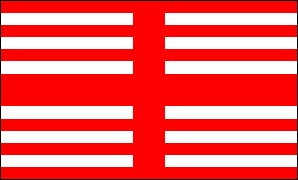ENSIGNS OF THE BRITISH EAST INDIA COMPANY
SEVENTEENTH CENTURY TO 1824
On 31 December 1600, Queen Elizabeth I granted a Royal Charter to George, Earl of Cumberland, and 215 associates as the “Governor and Company of Merchants of London trading with the East Indies.” This charter granted to the company a monopoly on trade with all countries east of the Cape of Good Hope and west of the Straits of Magellan. Thus was born the famous British East India Company, which was destined to bring the subcontinent of India under British imperial rule.
After initial setbacks, the East India Company’s affairs prospered and by 1650 it had some 25 “factories” (trading posts) on the Indian coast served by a fleet of trading vessels—the fabled East Indiamen, as these armed merchant ships were called. With the passage of time, the Company became more and more entangled in the internal political affairs of India, its coastal trading concessions gradually expanding into colonial enclaves. Eventually the John Company, as it was nicknamed, found it necessary to raise its own army and navy, the latter being known as the Bombay Marine. Territorial expansion continued and British primacy in India was firmly established by the defeat of her major European rival, France, in the Seven Years War. In the years that followed, the British government imposed more and more control over the Company’s activities, though legally the latter was still the sovereign power in India. The long reign of the John Company finally came to an end with the bloody Sepoy Mutiny of 1857. In its wake Parliament passed the Government of India Act (1858), transferring sovereign power in India to the British government. The East India Company itself was finally dissolved in 1874.
At the close of Elizabeth’s reign (1606) most English ships flew ensigns with the Cross of St. George in the canton and a field of variously colored stripes. One of King James I’s earliest acts was to lay down new regulations for the allowable flags of English and Scottish merchant ships. The former were to fly the new Union Jack at the main and the Cross of St. George at the fore. In 1634, King Charles I restricted the Union Jack to “the King’s ships,” leaving the Cross of St. George as the sole ensign of English merchant ships. In 1674, however, a Royal Proclamation established the Red Ensign and the Cross of St. George as the recognized flags for English merchant ships.
For the first few years of its existence, therefore, the East India Company’s ships probably flew striped ensigns, gradually switching to the plain Cross of St. George after 1606. Its distinctive ensign of red and white stripes seems to have been taken into use (with no official sanction) around 1660. Contemporary illustrations depict this ensign with a small St. George canton and a varying number of stripes—usually nine or thirteen. Most thirteen-stripe ensigns had seven red and six white stripes but variants with seven white and six red stripes are known to have been used as well. The canton changed to the First Union Jack in 1707 and to the Second Union Jack in 1801. The Company’s jack usually had nine stripes, five red and four white. A thirteen-stripe version—essentially a Cross of St. George with three red and three white stripes in each quarter—also existed and seemed to have been used as an ensign by vessels of the Bombay Marine. The Cross of St. George was used as a masthead flag and there was also a distinctive masthead pennant with the Cross of St. George at the hoist and the fly striped red-white-red.
The Admiralty, which was charged with the enforcement of maritime flag regulations, voiced many objections to these distinctive ensigns, jacks and pennants, which had never been authorized by warrant as required by the 1674 Royal Proclamation. In 1677, therefore, it was agreed that the Company’s ships would fly them only east of the Cape of Good Hope and south of the island of St. Helena in the Atlantic. Otherwise the Red Ensign would be flown. Finally, In 1824, the distinctive ensigns and pennants of the East India Company were formally abolished. Thereafter all Company ships flew the Red Ensign. It appears, however, that the thirteen-stripe jack continued to be used as an ensign by the Bombay Marine until at least the mid-1830s.
The obvious similarity of the post-1707 John Company ensigns to the first national flag of the United States—the Continental Colors—is probably coincidental, though the tea trade brought many Company ships to American harbors. In accordance with the 1677 agreement, of course, Company ships in American waters should have flown the Red Ensign, but the striped ensign was probably a common sight.
Flag Proportions: Contemporary illustrations show English and British flags of this period in various proportions. Those of the East India Company seem to have been proportioned roughly 3:5 after 1707, as depicted on this page. The post-1801 Red Ensign probably had 2:3 or 3:5 proportions in its early years; it is depicted here in its modern form (1:2 proportions).
